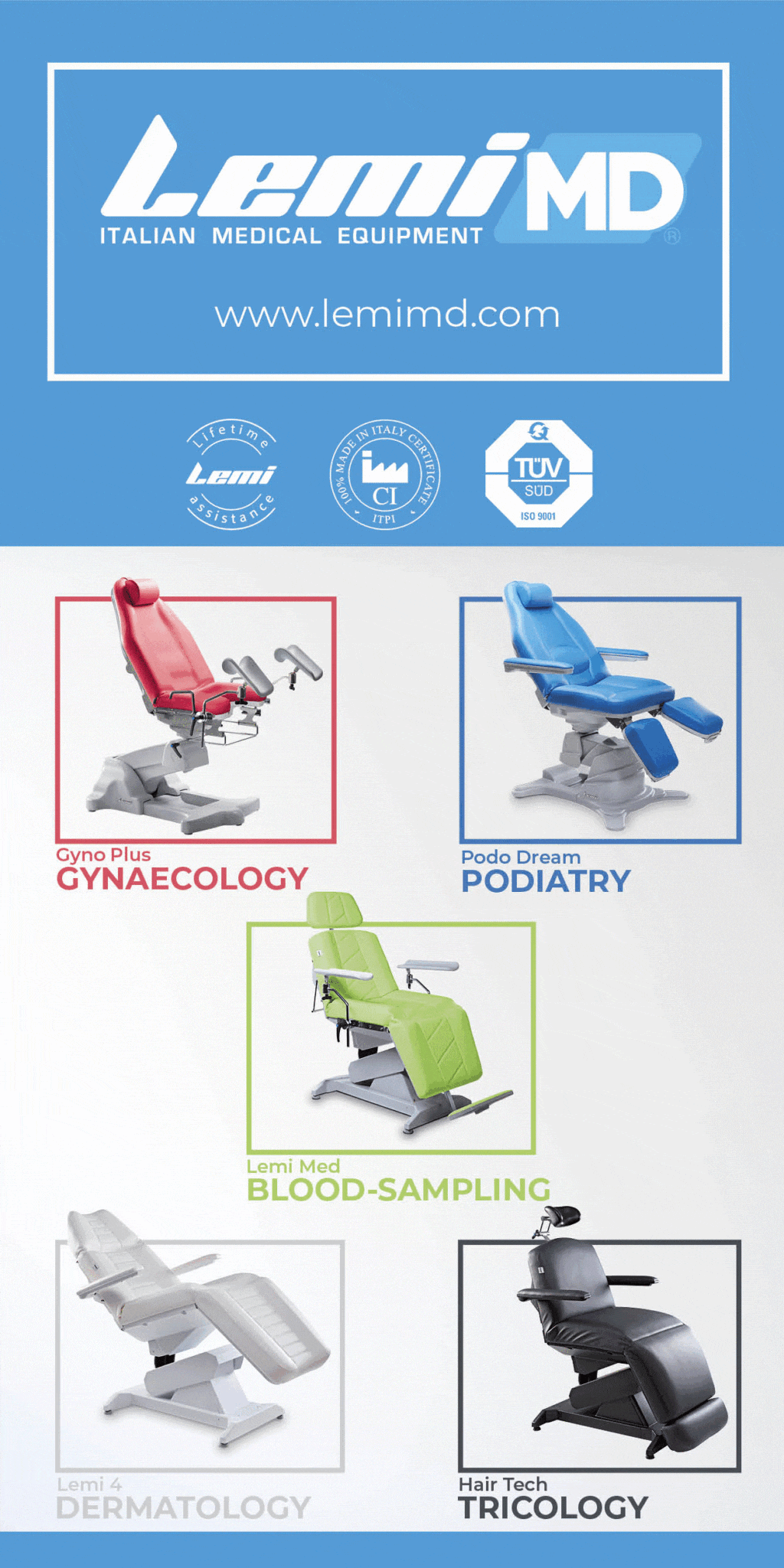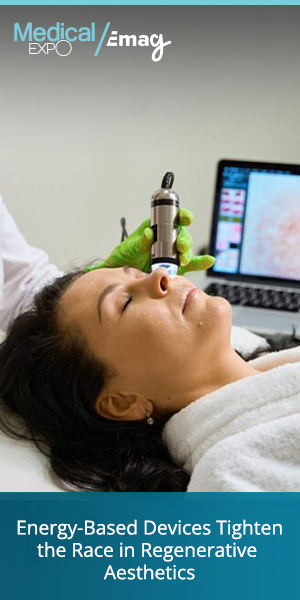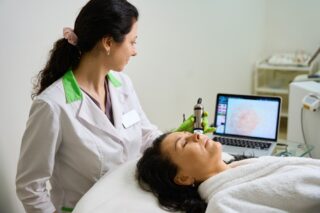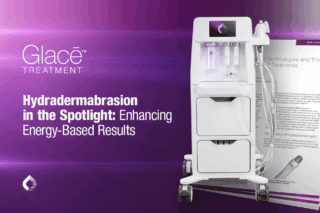Taiyo Corporation, a Japanese company founded in 1981, specializes in manufacturing medical devices. Their flagship product, the OPELAIII, is a wearable OR lighting system designed specifically for surgeons. Last week, Taiyo introduced its latest model, the OPELAIII Cx, at the MEDICA trade fair in Germany. Earlier this month, MedicalExpo had the opportunity to meet with the Taiyo team at their Tokyo headquarters for an exclusive preview of this new model.
Taiyo Corporation’s offices are located on the 9th floor of a building in Tokyo’s Minato district. There, Mariko Nakabe, President of Taiyo Corporation, Rawaf Radjaie, International Sales Director for the Medical Business Division and Ryokan Potier, Sales Promotion Director hosted the MedicalExpo team. The highlight of the day was the presentation of their latest innovation, the OPELAIII Cx, an advanced wearable OR lighting system. This new model builds on its predecessor, OPELAIII, and is designed for use by surgeons in both operating rooms and intensive care units.
According to Radjaie, the goal of the new model is straightforward:
“To make the OR light smaller and wearable.”
The concept is simple yet effective. Operating rooms are typically equipped with ceiling-mounted OR lights designed to illuminate the entire surgical area. However, surgeons often need additional lighting to precisely focus on specific areas during procedures, making a head-mounted lighting device particularly valuable.
The Evolution of OR Lighting
OPELAIII, which combines the words “operation” and “lights” with “III” for its three LED lights, was developed by Mariko Nakabe in collaboration with an engineer from a Japanese OR light manufacturer. The engineer noted a common issue with traditional OR lighting: ceiling-mounted lights can create shadows, which obstruct visibility during surgery. Nakabe explains:
“In terms of brightness, ceiling-mounted OR lights are extremely bright, thanks to their multiple LEDs. However, they are fixed in place, limiting their mobility. On the other end of the spectrum, traditional headlights offer mobility since they’re battery-operated and worn on the head, but they’re typically limited to a single LED, which doesn’t provide adequate brightness or shadowless effect.”
OPELAIII was developed to bridge this gap, delivering both brightness and mobility in one wearable solution. Nakabe elaborates:
“The operating room environment is becoming more compact, with equipment like endoscopes getting smaller. Yet, OR lights have remained unchanged, and they can’t reach deep or narrow areas effectively. This is why head-mounted lights have become more common, although they often lack the power of standalone OR lights. We aimed to develop a head-mounted light capable of supporting complex surgeries, such as those in cardiovascular areas, without needing the large, traditional OR light.”
With OPELAIII Cx (Cx stands for “customer experience”), Taiyo Corporation has taken a significant step forward, making OR lighting even smaller and lighter.

Key Features and Innovations
The new OPELAIII Cx model incorporates key upgrades compared to the previous version:
1/ High-Intensity, Eye-Safe Illumination
With three powerful LEDs, the OPELAIII Cx produces intense, evenly distributed light and achieves a maximum brightness of 160,000 Lux (vs. 145,000 Lux for the previous model). This aligns with the IEC standard for surgical lighting to protect surgeons’ eyes from strain or damage, Rawaf Radjaie explains:
“We see many competitors with lights that are far brighter than that. They don’t adhere to the IEC standard, but we prioritize safety.”
Besides, as noted by Ryokan Potier, Sales Promotion Director at Taiyo, who has demonstrated the product in real-life surgical settings with surgeons,
“The 160,000 Lux brightness is already very powerful. In my experience across numerous operations, this maximum brightness level is rarely needed. Some models on the market go as high as 300,000 Lux, but surgeons don’t actually require that extreme level of brightness—they need high-quality, focused lighting instead.”
2/ Enhanced Depth and Shadow Reduction
Unlike traditional headlights, which act like spotlights and illuminate only a focused area, the OPELAIII Cx’s three LEDs are strategically positioned to converge and create a three-dimensional light volume, Rawaf continues:
“This allows deeper penetration into surgical cavities and better lighting of the cavity walls, offering clearer visibility in challenging areas.”
Shadow reduction technology has also been significantly improved. The converging LED design minimizes shadows that typically obstruct the surgical field. This eliminates visual interference for the surgeon and enables a clearer view of the operation site.

3/ Uniform Light Distribution with a Gentle Fading Border
To improve visual comfort, the OPELAIII Cx maintains a soft, halo-like transition at the edges of the light field. This gentle fading border avoids harsh light boundaries and follows the IEC guidelines, reducing the strain associated with sharp contrasts between light and dark areas. This is often found in other devices. This design ensures that the light covers a larger area without compromising focus, effectively illuminating the entire surgical field.
4/ Minimal Heat Emission
LEDs naturally generate heat. And surgeons can operate for many hours, sometimes up to 10 hours. For its previous model, Taiyo Corporation addressed this issue by incorporating an aluminum cooling plate with built-in liquid channels to regulate temperature. But this was making the device heavier. For the new model, the company decided to use new-generation LEDs and larger lenses that produce less heat overall.
According to Rawaf,
“The lenses are larger, they allow for more efficient light emission and they minimize heat generation. Therefore, any part you touch around the device never exceeds 41 degrees. Besides, the whole device is also lighter.”
5/ Battery Technology
While many of their competitors use lithium-ion batteries, which can overheat, the OPELAIII Cx employs nickel-metal hydride (NiMH) batteries for improved stability.
The battery can last up to 12 hours at medium brightness and 4 hours at maximum brightness. Additional power indicators keep surgeons aware of battery levels.
6/ Compact, Lightweight, and Black
The OPELAIII Cx has been redesigned to be 50% smaller in size and 20% lighter than its predecessor, though for the team, it feels up to 50% lighter when worn.
According to Ryokan,
“When we introduced the original model, doctors understood the concept of a smaller, more compact OR light compared to traditional overhead lights. However, some surgeons mentioned that it felt a bit heavy at 390 grams, especially with the added weight of the battery.”
The device has therefore been reimagined in a sleek black color, “which gives it a more compact appearance”, said Mariko.
This new ergonomic design was developed in collaboration with a Japanese helmet manufacturer to ensure optimal weight distribution. It features a universal fit to accommodate different head shapes, with only two contact points at the front and back, eliminating pressure on the temples. The new, rounded shape also enhances comfort, making it suitable for prolonged use.
Additionally, they also provide a special belt designed to hold the battery. Since doctors often stand and look down for long periods their backs can become strained. This belt includes a lumbar support feature that provides extra back support. Ergonomics plays a big part in the design on the OPELAIII Cx.


Applications of the OPELAIII Cx
The OPELAIII Cx is designed to meet the diverse needs of various surgical disciplines, as well as unique applications in emergency and disaster relief settings where traditional lighting falls short. Here are the primary and emerging applications for the device:
1/ Primary Surgical Applications
The OPELAIII Cx is particularly useful in surgeries where the surgeon is standing and looking downward, such as gynecology, respiratory, and plastic surgery procedures. Traditional OR lights are positioned overhead to illuminate downward, providing adequate lighting in these cases. OPELAIII Cx enhances this setup with precision lighting, focusing on specific areas and providing shadow reduction directly where the surgeon needs it.
In procedures such as colorectal and certain gynecological surgeries, the patient is often positioned lying down with the legs elevated. Here, the surgeon typically sits and looks forward, rather than downward, to perform the surgery. Conventional OR lights struggle to adjust to this angle, but the OPELAIII Cx’s wide range of directional adjustment allows it to target the surgical area precisely, making it highly effective for these procedures.
The device is also effective in certain urological procedures, especially those requiring flexibility in lighting angle.
2/ Veterinary Medicine
Many veterinary clinics rely on outdated halogen lights, which are often insufficient for surgical procedures on animals. Besides, large animals, such as horses or cattle, often cannot be transported to veterinary clinics. This requires veterinarians to perform procedures on-site, a setup that generally lacks proper lighting.
OPELAIII Cx therefore provides a cost-effective, modern lighting solution for veterinary care in field environments.
3/ Disaster Relief and Emergency Response
The OPELAIII Cx has proven invaluable in field hospital setups during natural disasters. Following earthquakes in Turkey and Syria in February 2023, the Japanese disaster relief team brought the device to provide stable lighting in field hospitals, where conventional OR lights were unavailable.
Japan has pioneered mobile operating rooms within ambulances, equipped to perform emergency procedures en route. Due to the low ceilings and tight spaces in these vehicles, traditional OR lighting is not feasible. The OPELAIII Cx provides essential, high-quality lighting in these confined spaces, enabling emergency care on the move.
During the Tokyo Olympics in 2021, OPELAIII Cx was kept on standby in case of terrorist incidents or mass casualties. In such scenarios, it could provide immediate lighting for emergency medical interventions close to the stadium.
Mariko adds,
“OPELAIII Cx functions as a professional-grade light within hospitals, supporting complex surgeries alongside modern equipment. But it’s also highly effective in situations with unstable lighting or in developing regions. In Japan, where natural disasters like earthquakes and typhoons are common, even advanced hospitals can quickly turn into emergency zones. In these situations, OPELAIII can be deployed effectively, providing essential lighting support without relying on other equipment.”

Market Expansion
Currently, the new OPELAIII Cx is registered for sale in Japan, where mass production is set to begin at the end of February 2025. Taiyo. The company is allowing flexibility for adjustments, should any changes be necessary. When the original OPELAIII model was first released, it underwent testing with various doctors, and their feedback was incorporated into the design. The same approach is being applied to the new model to ensure it meets the needs of medical professionals.
While Taiyo is focusing on Japan for the initial rollout, the company is also targeting European countries for future distribution. The device received rave reviews at MEDICA in Germany, marking its first step into the worldwide launch for the Spring of 2025.
READ ALSO
Need help choosing the right surgical headlight? Read our buying guide











